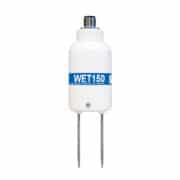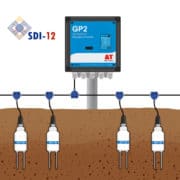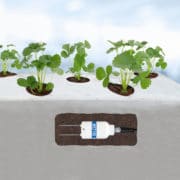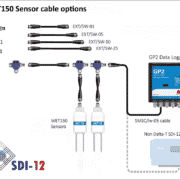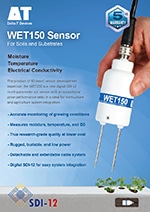- Overview
- Specification
- Accessories
- Product Resources How to Buy
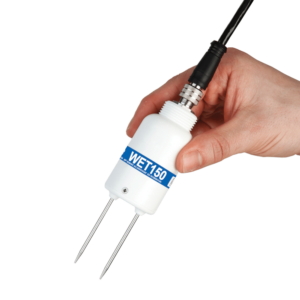
Testimonials
- Our latest research-grade soil sensor
- Measures moisture, temperature and EC
- Digital SDI-12 for easy system integration
- Rugged, buriable and low power
- Accurate monitoring of growing conditions
- Detachable and extendable cable system
- 5 year warranty
The digital multi-parameter WET150 soil sensor represents the culmination of forty years research and development at Delta-T Devices. Through a number of key design innovations it delivers research-grade accuracy and build quality at a price point not previously thought possible. It is the ideal sensor for research of soil conditions – and for integration into SDI-12 environmental and horticultural measurement/control systems.
Video – The Wet150 Sensor’s use in research and horticulture
A digital SDI-12 sensor that measures three crucial variables
When buried in soil or substrate the WET150 Sensor simultaneously measures three crucial variables that influence plant growth: moisture content, temperature, and electrical conductivity (EC) – a strong indicator of the general nutrient level.
A key strength of the WET150 is its ability to reliably calculate pore water conductivity (ECp), which is the ion content of the water available to the plant.
The WET150s patented sensor electronics produce research grade measurement accuracy with exceptional salinity and temperature stability – essential for critical control and irrigation decisions. When the sensor is buried, temperature measurement (essential for compensating the EC measurement – to obtain optimum accuracy) is taken directly from the root zone.
Accurate monitoring of soil and substrate conditions
When installed in growing media, the WET150 can provide the accurate data required to power effective SDI-12 enabled automatic precision irrigation and environmental control systems – enabling reduced use of water/fertilizer whilst improving yields and quality of produce.
The rugged watertight build of the WET150 also makes it ideal for use in field research and outdoor farming – sensors can be left buried over very long periods of time without loss of performance. WET150 sensors can also be buried at different depths to enable monitoring of soil moisture, temperature and EC profiles.
Digital SDI-12 Interface
The WET150 is a digital SDI-12 sensor (fully compliant with SDI-12 version 1.3 standards). SDI-12 is a standardised interface for connecting digital sensors to a master device – typically an SDI-12 compatible data logger, wireless node, controller, or computer. SDI-12 defines both the digital communications and sensor power standards.
A key strength of SDI-12 is that it supports the connection of multiple networked sensors to a single input on a SDI-12 enabled master device – cutting costs and complexity.
The WET150 (like all SDI-12 Sensors) is low power and features an integrated microprocessor that enables it to perform two way communication with an SDI-12 master device.
The WET150 outputs readings in a standard SDI-12 format which can be sent to, and recognised by, the master device. The inclusion of a microprocessor also gives the WET150 the ability to perform complex internal correction, compensation and averaging algorithms that enhance the quality of the data.
SDI-12 protocol is based on a master-slave configuration. When installed in an SDI-12 network, individually addressed WET150s (slaves) are sent data requests by the master device. These requests briefly wake all WET150s in the network – and result in a measurement and data sending response from the targeted WET150. When not responding to a master request, all WET150s remain in a dormant energy saving state.
The Key Benefits of SDI-12
- Use many sensors with just a single master device, reducing complexity and costs
- Low power systems that run off battery and are powered via the interface Bus
- Many parameters can be transmitted over simplified wiring
- No loss of accuracy over large cable runs.
- Ideal for wireless comms based applications
Cables and connectors
The WET150 has a high quality, stainless steel IP68 rated connector (M12 x 5-way) – connecting to the standard Delta-T range of M12 x 5-way cables and accessories.
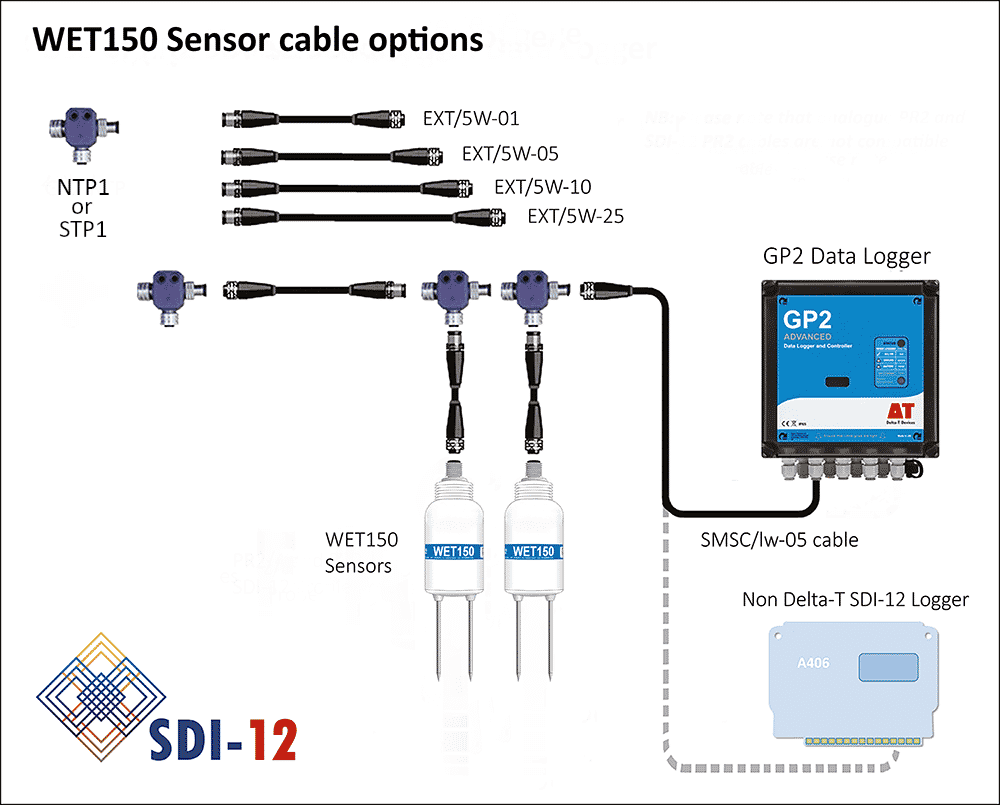
GP2 SDI-12 Data Logger – an ideal partner for the WET150
The WET150 is fully compatible with the SDI-12 enabled GP2 Data Logger and Controller – which features simple point & click configuration.
Up to 62 WET150s can be connected to a single GP2 SDI-12 Data Logger (subject to cable length and power requirements).
In addition to SDI-12 input, the GP2 can log 12 analogue channels. The SDI-12 enabled GP2 Data Logger and DeltaLINK enable quick and easy creation of sensor networks – without need to resort to the often complex programming methods typically employed by other manufacturers.
Due to the flexibility of the SD1-12 interface and the GP2 Logger, multiple power and cabling configurations may be possible when building a sensor network. Please refer to the WET150 User Manual for further information. Alternatively please contact sales@delta-t.co.uk to discuss your application in detail.
Easy installation
The WET150’s sharp and strong pins minimise soil and substrate disturbance, preserving the original structure around the measurement rods, and making the probe easy to insert and install. For burial at depth the cylindrical shape facilitates installation in augured holes. Optional extension tubes assist with placement and removal (50 cm and 100 cm lengths, connectable).
Applications
Soil science – The WET150 is easily integrated into SDI-12 systems and delivers research-grade accuracy and reliability for researchers monitoring soil or substrate conditions. Typical areas of use include irrigation research, crop trials, phenotyping, hydrology, soil water profiling, and forestry.
Horticulture and Agriculture – The WET150 Sensor is available with a comprehensive set of calibrations and provides a simple, effective, rugged solution to checking the uniformity of growing conditions for many types of growing media. The WET150 excels in measuring the variables required to monitor and control fertigation. It is also a powerful tool for sampling soil salinity levels (which can affect crop yields).
Precision Irrigation – The WET150 sensor is ideal for precision irrigation applications. The WET150’s compact design allows it to be easily installed in grow bags. The WET150’s accurate sensor data can be used to optimise irrigation scheduling, or drive an SDI-12 enabled automatic irrigation system.
System integration – The WET150’s accurate and stable three parameter measurement, simple SDI-12 output and low power make it the ideal sensor for system integrators. Industrial rated, UV resistant cable fitted with a waterproof IP68 connector allows the sensor to be buried indefinitely, whilst still permitting easy cable exchange or extension if necessary.
Data Logging and portable readout
The WET150 is a dual purpose soil moisture sensor. It can be installed in soil or substrate and connected to a SDI-12 master device (e.g. data logger) to provide long-term moisture, temperature and EC data. Alternatively it can be used in kit form as a portable sensor connected to the WET150 readout meter to take instant spot measurements of moisture content and EC (when used in portable mode the WET150 Sensor does not provide temperature indication).
Calibrations
The WET150 Sensor comes complete with calibrations for mineral and organic soils plus coir, peat, and mineral wool substrates soils.
WET150 Sensor development collaboration with National Physical Laboratory (NPL)
Measurement technologies developed by the UK’s prestigious National Physical Laboratory (NPL) have played an important part in the development of the WET150 sensor.
The National Physical Laboratory’s involvement in the project centred around the challenges of calibrating a sensor that simultaneously measures both the conductivity of soil (EC) and the permittivity of soil – from which readings of soil moisture are generated.
The collaborative work between Delta-T Devices and NPL enabled the creation of new proprietary dielectric fluids with permittivity and conductivity properties that are representative of those typically found in soils and soil-free growing media.
Specification
WET150 Sensor
VOLUMETRIC WATER CONTENT | PORE WATER CONDUCTIVITY (ECp) | PERMITTIVITY | BULK CONDUCTIVITY (ECb) | TEMPERATURE | |
ACCURACY |
± 0.03 m3.m-3 (3%)
|
See graph below this table
|
± (3% of reading + 0.8 ε’)
1 → 40
|
± (10mS.m-1 + 6%)
|
± 0.5°C
(0°C to +40°C range)
± 0.7°C
(-20°C to +60°C range)
|
± 5% of reading
40 → 80
| |||||
RANGE |
Full range:
0 to 1.0 m3.m-3
|
See graph below this table
|
for ECp ≤ 800 mS.m-1
1 → 40
|
from 0 to 1200 mS.m-1
|
Full range:
-20°C to +60°C
|
Accurate range:
0.05 to 1.0 m3.m-3
ECb 0 to 500 mS.m-1
|
for ECp ≤ 500 mS.m-1
40 → 80
|
Accurate range:
0°C to +40°C
| |||
OUTPUT |
SDI-12 protocol 1.3 (www.sdi-12.org) Providing water content, pore water conductivity, and temperature - together with base readings of permittivity and bulk conductivity. Outputs are exceptionally configurable. | ||||
POWER REQUIREMENT |
Operating voltage: 6 to 20 Volts Current consumption (typical values powered from 12 Volts): Active sensing: 22 mA average over 12 ms (average includes short peaks at 45 mA) Active results computation: 2 mA over 188 ms Idle: <0.5mA | ||||
ENVIRONMENTAL |
IP68, - 20 to + 60°C | ||||
SAMPLE VOLUME |
~55 x 70 mm diameter | ||||
Sample volume is weighted towards soil immediately surrounding the rods | |||||
DIMENSIONS |
Overall: 143 x 40 mm dia Rods: 51 mm x 2.5 mm dia | ||||
WEIGHT |
Weight: 77g (excl. cable) | ||||
SENSOR CALIBRATIONS |
Individual sensors are interchangeable Recalibration advised every 5 years (depending on use) | ||||
SOIL CALIBRATIONS |
The WET150 Sensor comes complete with calibrations for mineral and organic soils plus coir, peat, and mineral wool substrates | ||||

Notes: [1] The WET150 has been carefully optimised to provide accurate readings in soils and substrates - readings taken in water or air may not meet the full specification. [2] The ECp contour map is based on measurements from 30 sensors at 20°C in NPL* traceable media. Calculated ECp readings are derived from the Hillhorst equation, using the generalised “mineral” soil calibration and the default soil parameter = 4.1 * NPL is the UK's National Metrology Institute, developing and maintaining the national primary measurement standards.
Accessories
Hardware
Main components and software
Mountings and enclosures
Installation accessories
Cables and networks
- M12-TD Precision M12 Connector Torque Driver Tool
- STP1 Network T-Piece for connection to M12 cabling network
- EXT/5W Extension Cables
- NTP1 Network T-Piece for connection to M12 cabling network
- EXT/5W-25 25m extension cable, 5-way M12
- EXT/5W-10 10m extension cable, 5-way M12
- EXT/5W-05 5m extension cable, 5-way M12
- EXT/5W-01 1m extension cable, 5-way M12
Remote communications
Spares and consumables
Power options
Other
Product Resources
Case Studies
-
Using the WET150 for Teesdale plant species recovery research 6 MB
Dr David Oatway makes extensive used of the WET150 Soil Sensor in urgent plant species recovery research (Upper Teesdale, North of England - SSI).
Filename: Teesdale_WET150_Case_Study_ver_1 -
Seven brief Delta-T Devices soil moisture sensor case studies 2 MB
A diverse selection of fascinating soil moisture related application stories.
Filename: Seven_brief_soil_moisture_sensor_case_studies_v1 -
Lualtek use the WET150 Sensor to take crucial ECp readings for their smart systems 993 KB
Italian Agritech specialist Lualtek explain the benefits of the WET150 Sensor.
Filename: WET150_Lualtek_ECp_case_study_version_1 -
BBRO use WET150 to tackle drought risk in sugar beet 2 MB
Delta-T Devices is providing soil sensors to the British Beet Research Organisation for use in important water deficit research projects.
Filename: BBRO_WET150_case_study_v.1 -
Swansea University use WET150 to investigate sea turtle nest conditions 613 KB
Swansea University scientists and Local Ocean Conservation (LOC) in Kenya are working together to safeguard endangered sea turtle species.
Filename: Case_Study_Sea_Turtles_Swansea_Uni_WET150_Sensor_v.1
Software
Videos
Manuals
- WET150 Sensor User Manual 2 MBFilename: WET150-UM-01-2.0 (WET150_User_Manual_v2.0)
- WET150 Sensor Quick Start Guide 646 KBFilename: WET150_Quick_Start_Guide_v.3
- WET150 Kit Quick Start Guide 608 KBFilename: WET150_Kit_Quick_Start_Guide_v3
- WET150 SDI-12 Programmer Guide 438 KBFilename: WET150 SDI-12 programmer guide v2
FAQs
-
Setting up an M12 cable network to ensure a waterproof and secure connection.
Question
What is the best practice for setting up a M12 cable network to ensure a waterproof and secure connection..
Answer
It applies to:
GP2 for SDI-12 and logger networks.
Celora for SDI-12 networks.
All sensors with M12 connector cables.Examples of SDI-12 network and GP2 logger networks:
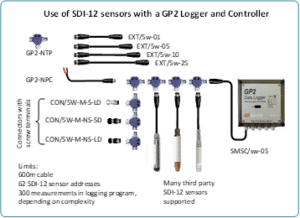
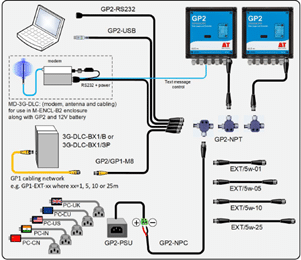
DO
When connecting multiple cables and T-piece together, it is essential that any M12 connector is tightened sufficiently:• Ensure internal connector O-ring and opposite sealing face are free from dirt.• Tighten the connector thumbscrews as much as you can by hand or use a torque driver set to 1Nm to be sure. See video:
We recommend the Weidmuller ‚”1900021000″ torque driver:
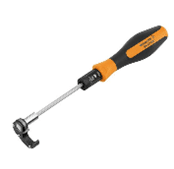
• This will save lots of painstaking troubleshooting hours if you do have a loose connection and give you piece of mind that all connectors are correctly tightened.
• Untightened connectors can come undone and let water into the cable network which can damage wire cores and cause erroneous readings.
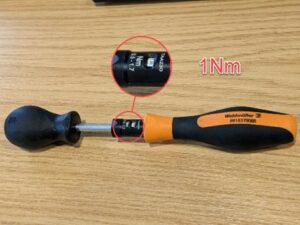
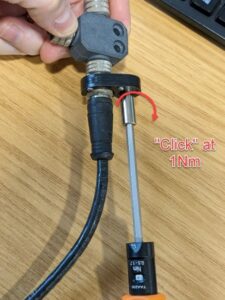
Connect in the office first and then transfer the network to the field. This way, you’re not trying to do it in unpleasant weather and the time pressures are off.
DON’T
Use duct tape. This will hold water against the connector. If tightened correctly, the connector will seal and hold. -
How to check a WET150 is functioning
Question
I would like to check my WET150 sensor is functioning, how can I do this?
Answer
Use a WET150 meter to connect directly to the WET150 sensor and measure the “RAW” soil type setting: Permittivity, ECb and Temperature
Press the SET button on the WET150 meter.
Scroll down to “Soil type”, press SET.
Scroll to “RAW” press SET

Air test:
Hold sensor with rods pointing up in the air.
Press the “Read” button.
Permittivity (…õ) should = 1 (+/- 0.5)
ECb should = 0 (+/- 1mS.m-1).

Tap water test:
Fill a 1 litre container of tap water.
Insert the WET150 sensor into the middle of the water container, rods facing down into the water. Ensure the rods are covered by the water but not too deep – the water should not reach the side screws in the body of the WET150.
Ensure there is sufficient water around the rods (at least ~2cm from side walls and bottom of container).
*note this is very important! If the rods are too close to the side walls or bottom of the container, the sensing field will breach the container and you’ll be reading air/container material as well as the water. This will reduce the reading significantly.

Press the “read” button on the WET150 meter and note down the temperature and permittivity readings.

Using the temperature reading (in degC), work out what the estimated permittivity should be using: 87.48 – 0.365(T) where T is the temperature in degC:
87.48 – (0.365 x 24.7) = 78.5
WET150 permittivity (ɛ) should be reasonably close to the estimated value worked out using the temperature value above. Note: this is a rough test so the accuracy is not a strict limit.
The results from the temperature calculation above are 78.5 compared to the sensor reading of 79.5.
This is just a check to see if the sensor is in the correct region but, even with the published accuracy of +/-5%, the sensor is responding very closely.
Hanna fluid test:
Obtain a bottle of Hanna conductivity calibration fluid, for example the 1413uS/cm-1 (HI-70031P 1413µS/cm Conductivity Solution, x25 Sachets (hannainstruments.co.uk)

You will need enough fluid to fill a container so that, when the WET150 rods are inserted, they have a sufficient amount of fluid between the rods and the side and bottom of the container (at least ~2cm).
As above, insert the sensor into the middle of the fluid, rods facing down, water level no higher than the screws in the side of the body. Please note warnings about the sensor being too close to the side/bottom of the container – this will significantly reduce the reading.
ECb should match Hanna fluid +/- 5% +/-100uS.cm-1. However, take note of the temperature! The Hanna 1413 fluid specification is at 25degC. If the temperature is different from 25degC, use the look-up table on the side of the bottle to see what the reading will be at different temperatures
For example, at 24degC, the 1413uS/cm-1 solution should be 1386uS.cm-1 but, given the accuracy of the WET150, this means that any reading between 1216 and 1555uS.cm-1 is acceptable. In reality, we would expect it to be closer though: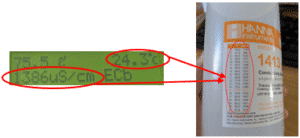
*Note: pay attention to the units. You can change the units on the WET150 meter so you can read the same units as the Hanna solution (uS.cm-1).
Technical Notes
-
Options for connecting WET150 SDI-12 sensors to a GP2 Data Logger 374 KBFilename: Connecting_WET150_SDI-12_sensors_to_a_GP2_Data_Logger_ver_1


